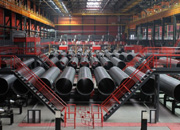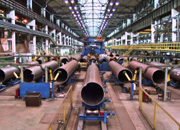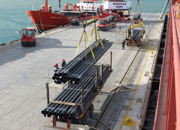What are the measures to improve the fatigue strength of welded steel structures
Update:2025-04-09 View(s):35 Keywords :steel welded structures, steel welded structures strength, steel welded structures quality
Any welding defect has different degrees of stress concentration, especially sheet welding defects such as cracks, incomplete penetration, lack of fusion, and undercut, which have the greatest impact on fatigue strength. Therefore, in the structural design, it is necessary to ensure that each weld is easy to weld to reduce welding defects, and defects that exceed the standard must be removed.
1. Reduce stress concentration fatigue crack source stress concentration points on welded joints and structures
(1) Adopt reasonable structural forms
① Give priority to butt joints, and try not to use lap joints; important structures should change T-joints or corner joints to butt joints so that the welds avoid the corners; when using T-joints or corner joints, it is hoped to use full penetration butt welds.
② Try to avoid eccentric loading design, so that the internal force of the component is transmitted smoothly and evenly distributed, and no additional stress is caused.
③ Reduce cross-sectional mutations. When the plate thickness or plate width is very different and needs to be butted, a gentle transition zone should be designed; the sharp corners or corners on the structure should be made into arcs, and the larger the radius of curvature, the better.
④ Avoid the intersection of three-way welds, try not to set welds in stress concentration areas, and try not to set transverse welds on major tensile members; when it is unavoidable, the internal and external quality of the weld must be guaranteed to reduce stress concentration at the weld toe.
⑤ For butt welds that can only be welded on one side, permanent pads are not allowed to be placed on the back of important structures; avoid using intermittent welds because there is a high-stress concentration at the beginning and end of each weld.
(2) Correct weld shape and good internal and external quality of welds
① The residual height of the butt joint weld should be as small as possible, and it is best to plan (or grind) it flat after welding without leaving any residual height;
② For T-joints, it is best to use fillet welds with concave surfaces instead of convex fillet welds;
③ The weld toe at the junction of the weld and the parent material surface should have a smooth transition. If necessary, the weld toe should be ground or remelted by an argon arc to reduce stress concentration at this location.
2. Adjust residual stress
The residual compressive stress on the surface of the component or at the stress concentration point can improve the fatigue strength of the welded structure. For example, by adjusting the welding sequence, local heating, etc., it is possible to obtain a residual stress field that is conducive to improving fatigue strength. In addition, surface deformation strengthening, such as rolling, hammering, or shot peening, can also be used to plastically deform the metal surface harden it, and generate residual compressive stress on the surface to achieve the purpose of improving fatigue strength.
For components with notches, a one-time pre-overload stretching can obtain residual compressive stress at the top of the notch. Because after elastic unloading, the sign of the notch residual stress is always opposite to the sign of the notch stress during (elastic-plastic) loading. This method is not suitable for bending overload or multiple tensile loading. It is often combined with structural acceptance tests, such as when pressure vessels are subjected to water pressure tests, it can play a pre-overload stretching role.
3. Improve the organization and performance of materials
First of all, improving the fatigue strength of the parent metal and weld metal should also be considered from the intrinsic quality of the material. The metallurgical quality of the material should be improved and the inclusions in it should be reduced. Important components can use materials from smelting processes such as vacuum melting, vacuum degassing, and even electro-slag remelting to ensure purity; grain refinement at room temperature can improve fatigue life; heat treatment can obtain the best organizational state, which can improve strength while also improving its plasticity and toughness; tempered martensite, low-carbon martensite, and lower bainite have high fatigue resistance. Secondly, strength, plasticity, and toughness should be reasonably matched. Strength is the ability of a material to resist fracture, but high-strength materials are sensitive to notches. The main function of plasticity is to absorb deformation work, reduce stress peaks, and redistribute high stress through plastic deformation, while also passivating notches and crack tips, and easing or even stopping crack expansion. Plasticity can ensure that strength is fully exerted. Therefore, for high-strength steel and ultra-high-strength steel, trying to improve plasticity and toughness a little will significantly improve its fatigue resistance.
4. Special protection measures
Atmospheric medium erosion often affects the fatigue strength of materials, so it is beneficial to use a certain protective coating. For example, applying a plastic layer containing fillers at stress concentrations is a practical improvement method.
 Threeway Steel is known as a professional supplier engaged in manufacturing and distributing a wide range of steel pipe, and our headquarter located the central part of China – Hunan and six associated factories throughout China.
Threeway Steel is known as a professional supplier engaged in manufacturing and distributing a wide range of steel pipe, and our headquarter located the central part of China – Hunan and six associated factories throughout China.
 Threeway Steel is known as a professional supplier engaged in designing, manufacturing and distribution of a wide range of steel products with the headquarter located the central part of China – Hunan and six associated factories throughout China.
Threeway Steel is known as a professional supplier engaged in designing, manufacturing and distribution of a wide range of steel products with the headquarter located the central part of China – Hunan and six associated factories throughout China.
 Threeway Steel is known as a professional supplier engaged in designing, manufacturing and distribution of a wide range of steel products with the headquarter located the central part of China – Hunan and six associated factories throughout China.
Threeway Steel is known as a professional supplier engaged in designing, manufacturing and distribution of a wide range of steel products with the headquarter located the central part of China – Hunan and six associated factories throughout China.
 Threeway Steel is known as a professional supplier engaged in designing, manufacturing and distribution of a wide range of steel products with the headquarter located the central part of China – Hunan and six associated factories throughout China.
Threeway Steel is known as a professional supplier engaged in designing, manufacturing and distribution of a wide range of steel products with the headquarter located the central part of China – Hunan and six associated factories throughout China.
 Threeway Steel is known as a professional supplier engaged in designing, manufacturing and distribution of a wide range of steel products with the headquarter located the central part of China – Hunan and six associated factories throughout China.
Threeway Steel is known as a professional supplier engaged in designing, manufacturing and distribution of a wide range of steel products with the headquarter located the central part of China – Hunan and six associated factories throughout China.

